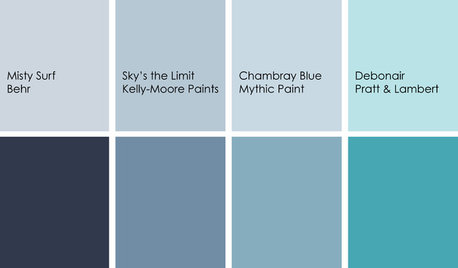What are you using for browns?
momamamo
15 years ago
Related Stories

COLORHow to Use Marsala, Pantone’s 2015 Color of the Year
Pantone digs deep and goes earthy with its selection. Here are ways to make it work in your home
Full Story
BLACKCooking With Color: When to Use Black in the Kitchen
Consider sampling Caviar or Cracked Pepper on your kitchen walls or cabinets for richness and impact
Full Story
DECORATING GUIDESColor Feast: Yes, You Can Use Blue in the Dining Room
The sky's the limit for beautiful blues in your home's dining spaces; here's how to make it work
Full Story
DECORATING GUIDES9 Ways to Use Rich, Dark Paint
See how deep colors — navy blue, charcoal, dark chocolate — can bring out your home's best details
Full Story
ORANGEColor Guide: How to Use Yellow Ocher
Earthy and warm, this ancient color evokes the sands of time as well as speaks to modern decorating sensibilities
Full Story
TURQUOISEColor Guide: How to Use Teal
This blue-green color is a versatile classic for walls, furniture and accessories, conjuring everything from the tropics to the Tropicana
Full Story
COLORWhy You Should Give Brown a Chance
If 'blech' is your first response to brown, you're missing out on the opportunity for a warm-looking room that appeals to both sexes
Full Story
COLORBest Ways to Use the Neutral Green Color of 2015
Benjamin Moore’s Color of the Year is soft and natural
Full Story
COLORBathed in Color: When to Use Gray in the Bath
Go for elegance and sophistication without going overboard on coolness, using these gray bathroom paint picks and inspirational photos
Full Story
DINING ROOMSColor Feast: When to Use Gray in the Dining Room
The right shade of gray pairs nicely with whites and woods to serve up elegance and sophistication
Full StorySponsored
Columbus Area's Luxury Design Build Firm | 17x Best of Houzz Winner!





bpgreen
digdirt2
Related Discussions
Soil and 'browns' for use in compost
Q
adding browns
Q
Brown, brown, brown
Q
If you like brown fantasy quartzite, what other stones do you like?
Q
Flowerhen
treeinnj
digdirt2
momamamoOriginal Author
kqcrna
d_giffin
joepyeweed
treeinnj
digdirt2
treeinnj
kqcrna
trancegemini_wa
shebear
led_zep_rules
luckygal
maryjane43
trancegemini_wa
kqcrna
tetrazzini
kqcrna
digdirt2
wonderpets
bpgreen
wonderpets
digdirt2
bpgreen
wonderpets
trancegemini_wa
wonderpets
petalpatsy
digdirt2
led_zep_rules
kqcrna
msyoohoo
sudzy
blutarski
momamamoOriginal Author
snidelywhiplash z5b
momamamoOriginal Author